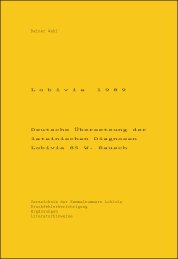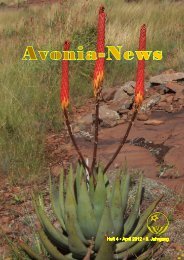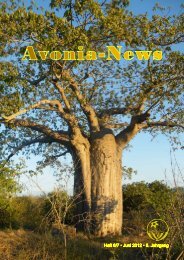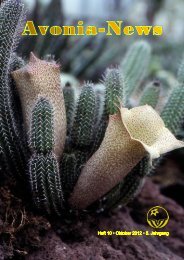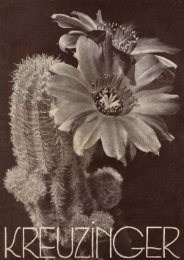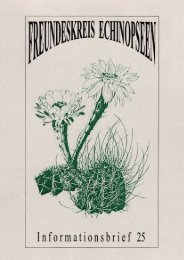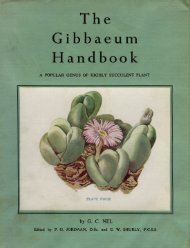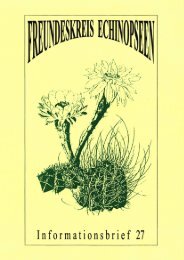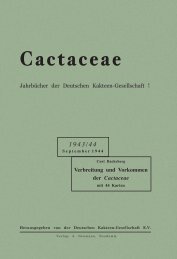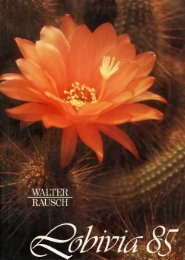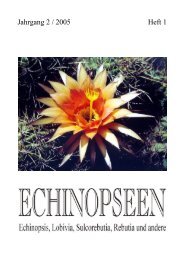Lithops - Au Cactus Francophone
Lithops - Au Cactus Francophone
Lithops - Au Cactus Francophone
Create successful ePaper yourself
Turn your PDF publications into a flip-book with our unique Google optimized e-Paper software.
Upington: Geelkop: Dry; Sept. 1939; Fl. Hort. Bot. Univ. Stellen bosch;<br />
13 Apr. 1943, 5 p.m.<br />
✱<strong>Lithops</strong> chrysocephala. This <strong>Lithops</strong> was received from Mr. Dry of<br />
Geelkop, but the exact locality is unknown. It resembles in colour Argyroder‑<br />
ma testiculare. This species is characterised by (1) an opaque light grey white<br />
(silvery white) window and (2) dark green transparent lines. At one stage<br />
in the life of the plant these lines seem to divide the upper lobe into 3–4<br />
equal rectangular areas. The inner margin is dark green and parallel with<br />
this runs a second similar line connected with the former margin by 3–4<br />
lines, and these connecting lines divide the upper surface into 3–4 subequal<br />
areas. These two lines are about 5 mm. apart. From this second line, which<br />
passes through the middle of the lobe, 3–4 lines run to the outer margin<br />
and end there. At the intersection of these lines transparent rectangular areas<br />
are formed, and in these areas small dark red dots embedded in the tissue or<br />
colouring the tissue are found. Flower white.<br />
As regards the above features it appears that these characteristics are<br />
not constant. At a later stage in the life of the plant, the lobes are slightly<br />
convex and the upper surface is divided into a number of areas or wrinkles,<br />
each of which is slightly raised above the level of the dividing depressions.<br />
The general appearance is thus a slightly wrinkled one. At the intersection of<br />
these lines and at other points a few dark red dots or lines occur. The in<br />
ner margin more or less straight and in this are found a varying number of<br />
dark red lines or dots in the tissue. The lines ending in the outer margin are<br />
either straight or slightly bifurcated. These red colourations are in the tissue.<br />
Although this plant conies ostensibly from a locality near to where L. insularis,<br />
L. Bromfieldii, L. Mennellii occur, yet it is a distinct species. In some respects<br />
it resembles L. Fulleri, but the outer and inner margin of L. Fulleri is much<br />
more lobed, and in these lobes there is a distinct dark colouration absent in<br />
the above species. From L. Mennellii it differs in that the lines of L. chryso‑<br />
cephala are dark green, those of L. Mennellii black, and the upper lobe of the<br />
latter is far more subdivided (Hebrew script).<br />
The coloured plate (Plate 6) shows the nature of the lobe of the plant<br />
at one stage in its life very well. Fig. 20 is a photo of this plant in 1939 and<br />
as originally described. Fig. 21 is a photo of the same plant a few years later.<br />
Fig. 22 is the same plant as shown in Fig. 20 but after 6–8 years. These photos<br />
show conclusively that one cannot rely too much on the markings of the up<br />
per surface as this tends to change beyond recognition. These photographs and<br />
those of L. Inae show quite definitely that great care has to be exercised in<br />
making use of the markings of the lobes, as these markings are very liable to<br />
variation. It is not sufficient to make an accurate drawing of only one lobe and<br />
from that fix the characters of the species. These lobes are after all only leaves,<br />
and it is a matter of experience that leaves show a great deal of variation.<br />
In determining the characters of species this must be borne in mind.<br />
62



